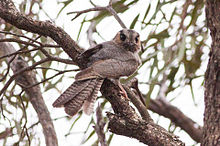| Apodimorphae | |
|---|---|
 | |
| Australian owlet-nightjar, Aegotheles cristatus | |
 | |
| Common swift, Apus apus | |
| Scientific classification | |
| Domain: | Eukaryota |
| Kingdom: | Animalia |
| Phylum: | Chordata |
| Class: | Aves |
| Clade: | Strisores |
| Clade: | Vanescaves |
| Clade: | Apodimorphae Sibley et al., 1988 |
| Subtaxa | |
| |
Apodimorphae is a clade of strisorean birds that include the extant families Trochilidae (hummingbirds), Hemiprocnidae (treeswifts), Apodidae (swifts), Aegothelidae (owlet-nightjars), and many fossil families. This grouping of birds has been supported in a variety of recent studies. [1] [2] [3] [4] [5] [6] There are two higher classification schemes that have been proposed for the apodimorph families. One is all strisorean birds are classified in the order Caprimulgiformes, [3] [5] while the other is the strisorean birds are split into several distinct orders. In this case Apodimorphae is a subclade of Strisores that includes the orders Aegotheliformes (only including the owlet-nightjars of Australasia) and the Apodiformes (the swifts, treeswifts, and hummingbirds which have a global distribution). [2] [4] [6]
The name Daedalornithes [1] has also been used for the clade comprising owlet-nightjars, hummingbirds, and swifts. Daedalornithes and Apodimorphae have different definitions. Daedalornithes is defined as the crown group (the least inclusive clade that includes Aegotheles cristatus and Apus apus) [6] whereas Apodimorphae referring the total-group (the most inclusive clade including Aegotheles cristatus and Apus apus but not Caprimulgus europaeus , Steatornis caripensis , Nyctibius grandis , or Podargus strigoides , a definition that includes fossil lineages more closely related to Daedalornithes than they are to other Strisores)